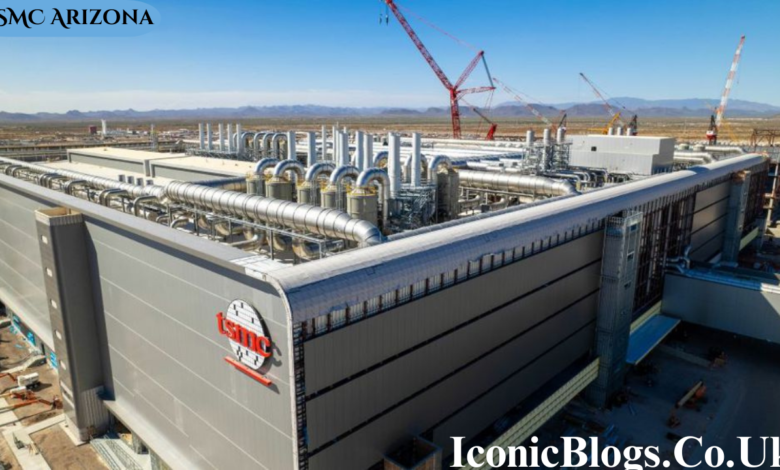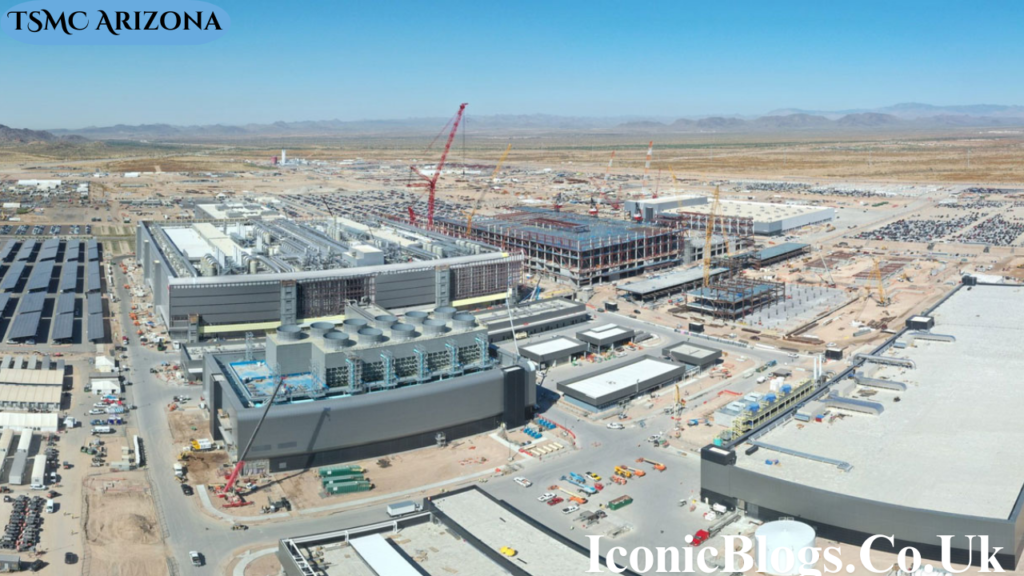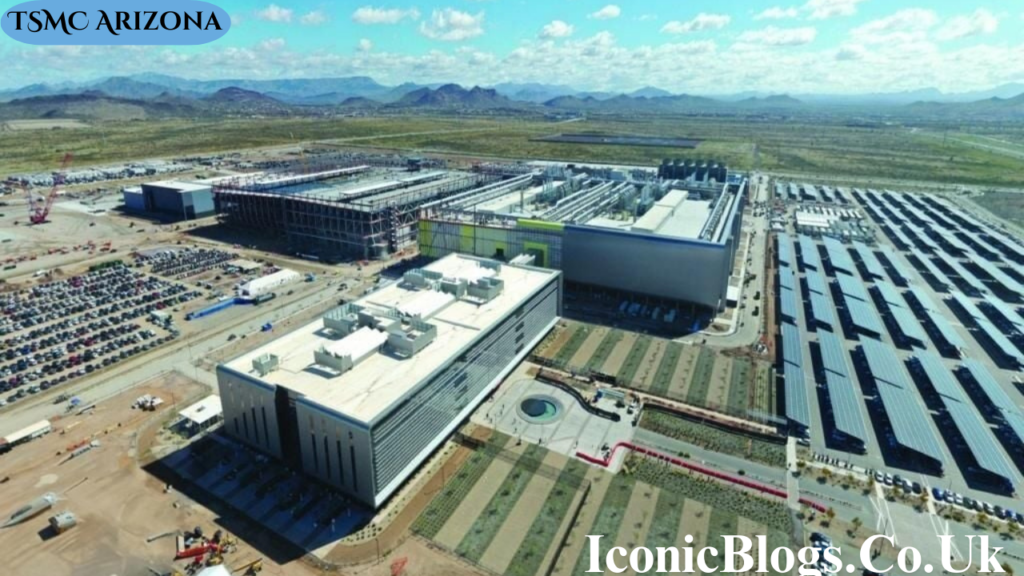TSMC Arizona: A New Era of Semiconductor Manufacturing in the U.S.

What is TSMC Arizona?
TSMC Arizona is an ambitious initiative by Taiwan Semiconductor Manufacturing Company (TSMC) in the United States, notably in Arizona. To develop a multi-billion-dollar fabrication unit (or “fab,” in the industry lingo) in Arizona is a milestone for TSMC, one of the top chipmakers in the world, technologically and geopolitically. It implies a paradigm change in global supply chains and the U.S. attempts to reestablish itself in sophisticated semiconductor manufacture.
Strategic Importance of Arizona
Arizona has long been a favorite of IT businesses, given its business-friendly climate, talented workers, and closeness to logistical centers. That TSMC picked Arizona as its site for the U.S. presence is not just chance. The plausible inference, then, is that the U.S. government and TSMC purposefully intended to relocate semiconductor manufacturers away from East Asia to decentralize the production processes and decrease dangers associated with geopolitical issues affecting the Taiwan Strait.

TSMC Arizona was also positioned in response to the increased need for sophisticated microchips employees in any setting, spanning from cellphones to military systems. The U.S. would become less reliant on foreign suppliers and better service in terms of national security.
“Project Overview: Scope, Timeline, and Investment
Initially proposed in 2020, TSMC Arizona imagined building a $12 billion factory in north Phoenix. This fab is expected to make 5-nanometer devices, some of the most advanced semiconductors in existence. In 2022, TSMC announced a second phase with a $28 billion investment that would be focused on making 3-nanometer semiconductors.
With the overall investment approaching to $40 billion, the TSMC Arizona project is one of the biggest foreign direct investments in U.S. history. The project is being planned out in stages, with the first fab set to enter operating in 2025. Further plans have been drawn up for a third phase, which may integrate even more advanced 2-nanometer technology.
Economic and Employment Impacts
TSMC Arizona will give a major economic boost to the area. Projects are estimated to produce around 4,500 direct high-tech employment and tens of thousands in indirect jobs via suppliers, service providers, and infrastructural activities. Arizona State University and numerous others in the area have developed programs to train the work force for the high-tech sector.
This initiative is developing Arizona into a global center for innovation and making the U.S. a formidable contender in the semiconductor manufacturing industry. The ripple effect on employment is huge from engineers and technicians to workers in construction and logistics.”
National Security and Supply Chain Resilience
The COVID-19 epidemic revealed a harsh truth about the instability of global supply networks, notably for semiconductors. Industries across the board- automotive, electronics, and health all hit to varying extents by delays, mostly owing to chip shortages. TSMC Arizona is a vital element of a bigger national effort to develop a more robust and secure supply chain.
By diversifying the geographic sites of chip manufacture, the United States can buffer itself from international disruptions and possible threats. In essence, these minerals are necessary for all sorts of consumer electronics as well as military gear, hence home manufacture has even more relevance from a national security standpoint.
Technological Advancements: What Will TSMC Arizona Produce?
The Arizona fab will start with the fabrication of 5nm circuits that are crucial for high-performance computing, AI applications, and current smartphones. These have improved performance with reduced power consumption and more transistor density than the preceding generations.

The second fab will go a step further by creating 3nm chips, which are even more sophisticated and vital for future advancements in autonomous driving, machine learning, and 6G telecommunications. Should the third phase come to reality, the facility could make 2nm chips, essentially placing the U.S. at the cutting edge of semiconductor technology.
Environmental Issues and Sustainability
The Arizona project of TSMC will probably have one of the biggest semiconductor fabs on this planet. Though it will demand huge amounts of water and power consumption, it must treat environmental concerns as real, notated above all in a dry region like Arizona, where water scarcity is already a concern. TSMC pledged advanced environmental initiatives in its environment of operations in Arizona, including sophisticated water recycling systems and energy-efficient production procedures.
The company collaborates with local utilities to obtain a reliable green energy source for activities. Such are the necessary progressions in making the balance between industrialization and the corresponding sustainable ecology.
Coordination with the U.S. Government and Industry
Co-making the very important factor in the steady success of the TSMC Arizona project is its close cooperation with the federal government of the United States and the state government in Arizona, in terms of tax rebates, construction of infrastructure, and training of employees, which have made it great for advancing this mega project.
TSMC also wants to help involve partnerships between major U.S. technology firms such as Apple, NVIDIA, and AMD, because these companies are expected to become some of the most crucial customers for chips produced in Arizona. Such close integration of supply chains provides support to the local technological ecosystem while boosting innovation.
Obstacles and Delays
Labor shortages, construction delays, and the hurdles of importing sophisticated machines have hindered progress. Besides, TSMC must deal with operational and cultural differences between the U.S. personnel and Taiwan headquarters.
The talent gap is another challenge. More techies are coming into Arizona, but the most qualified skills for advanced chips are scarce. TSMC tackles this by bringing in talented engineers from Taiwan to educate American staff-mainstream students and sponsoring academia-related projects learning supply.
Research and Education Opportunities
Such a fab that develops production operations, TSMC Arizona will also develop capabilities for R&D and innovation. Partnership with prestigious universities, such as Arizona State University and the University of Arizona, is expected to benefit collaboration, internship, and research projects development.
Through such educational alliances, the next generation of semiconductor engineers, researchers, and technicians would be nurtured and ensure the flow of talent for years to come.
Global Implications of TSMC Arizona
The establishment of TSMC Arizona is reshaping the global semiconductor industry. Other governments are also watching intently, contemplating similar investments in Europe, India, and Southeast Asia. The US expansion of TSMC seems to be an early signal that the global technology supply chain is entering a new era with diversity and decentralization.
It, moreover, depicts the growing importance of ‘technology sovereignty,’ in which governments try to guarantee their own access to crucial technologies.
Community and Cultural Impact
Indeed, this has become a great attribute that has been added onto TSMC Arizona, apart from its anaesthetizing and technical achievements, which have amounted to such high effects on the local community. Housing demand, transportation infrastructure, and public services have all coped with increased staffing, transporting workers and their families. Businesses in the locality are thriving while the place becomes more diverse and cosmopolitan.

Community involvement programs, cultural exchange projects, as well as TSMC charitable endeavors help uplift the company into the local community. Such symbiotic interaction surely works for both the business and the well-being of the community.
Demand Driver for Arizona’s TSMC Future
In that future, TSMC Arizona is certainly going to take a positive role in the development of American technology in general. With continued innovation and growth, this site may be well poised to become a worldwide center for the manufacture of next-generation chips. The most cutting-edge semiconductor plant in the world may well be built in Arizona, should TSMC decide to go ahead with its third phase.
Additionally, the success of these types of investments in the United States by other companies such as Samsung and Intel will now depend on how well this project goes. The outcome of TSMC Arizona will be one of the indicators of the larger ambitions of the nation within the semiconductor industry.
In conclusion
It is more than a plant; this TSMC Arizona is a metaphor for change in the economy, change in strategy, and revival in technology. This represents a very important step in the U.S. efforts to reclaim its erstwhile glory as the world’s leading producer of semiconductor devices. Though TSMC Arizona promises extremely promising investment development, strong government support, and a pledge to innovation, it will affect more than just the state of Arizona in the future; it will change the future of the global IT industry.
It incorporates cell phones to space missions, and TSMC Arizona is what progresses, persists as well as provides hope into an increasing digital world.
Also Read: 5 Best LearnDash Advanced Features to Enhance Your Quizzes
